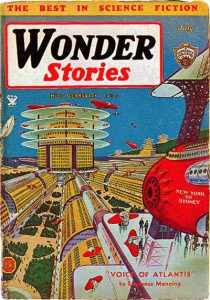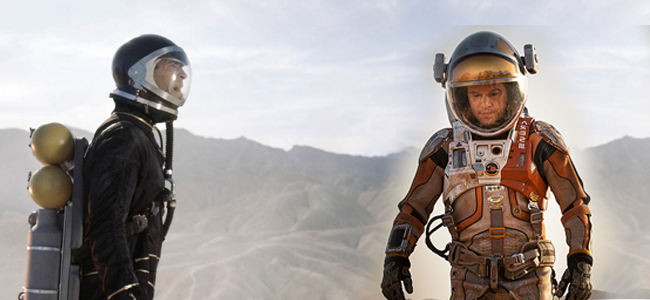This past week Ridley Scott’s THE MARTIAN, based on the breakout hit novel by Andy Weir, opened in theaters and it started doing fantastic business and has provoked mostly positive reviews. More importantly it has got people thinking seriously about a manned mission to the planet Mars.
I haven’t seen the film yet but I think that it’s fantastic that there is a (mostly) scientifically accurate science fiction movie playing that is getting so much attention.
But Matt Damon’s Mark Watney is hardly the first Earthman stranded on Mars. Heck, no! Mars is lousy with stranded Earthmen.
Let me show you just two examples.
 Back in 1934 Stanley G. Weinbaum wrote a short story for Wonder Stories Magazine called A Martian Odyssey. It was only his second professional sale but it cemented his reputation as a science fiction writer and it is still his most well known work. In the story, which takes place in the 21st century, a four man crew of the spaceship Ares has landed on Mars in the Mare Cimmerium. A week after the landing, Dick Jarvis, the ship’s American chemist, sets out south in an auxiliary rocket to photograph the landscape. Eight hundred miles out, the engine on Jarvis’ rocket gives out, and he crash-lands into one of the Thyle regions. Rather than sit and wait for rescue, Jarvis decides to walk back north to the Ares.
Back in 1934 Stanley G. Weinbaum wrote a short story for Wonder Stories Magazine called A Martian Odyssey. It was only his second professional sale but it cemented his reputation as a science fiction writer and it is still his most well known work. In the story, which takes place in the 21st century, a four man crew of the spaceship Ares has landed on Mars in the Mare Cimmerium. A week after the landing, Dick Jarvis, the ship’s American chemist, sets out south in an auxiliary rocket to photograph the landscape. Eight hundred miles out, the engine on Jarvis’ rocket gives out, and he crash-lands into one of the Thyle regions. Rather than sit and wait for rescue, Jarvis decides to walk back north to the Ares.
Along the way he encounters native martians, which are bird-like, intelligent creatures who have to contend with tentacled dream beasts who psychically induce hallucinations into their prey before eating them.
Jarvis and his new Martian friend, Tweel, travel together back to Jarvis` spacecraft. Along the way they find pyramids, carbon based life forms, canals (thank you, Percival Lowell) , a healing crystal and strange cart creatures who repeat Jarvis`s words like deranged parrots.
 It would be a stretch to suggest that A Martian Odyssey was as scientifically accurate as a writer could get at the time it was published. In the absence of facts Weinbaum was more free to create a compelling adventure rather than a stolid, fact laced scientific treatise. Nevertheless, his story struck a cord and it has regularly been singled out as one of the greatest science fiction stories of all times, right behind Isaac Asimov`s Nightfall.
It would be a stretch to suggest that A Martian Odyssey was as scientifically accurate as a writer could get at the time it was published. In the absence of facts Weinbaum was more free to create a compelling adventure rather than a stolid, fact laced scientific treatise. Nevertheless, his story struck a cord and it has regularly been singled out as one of the greatest science fiction stories of all times, right behind Isaac Asimov`s Nightfall.
Today`s readers, especially in light of Andy Weir`s nuts and bolts novel, will very likely conclude that Weinbaum`s story has dated badly with a plot as thin as the Martian atmosphere, but for sheer invention, few could touch it. An interesting little fact: The spacecraft in The Martian is called the Ares 3. A little nod towards Weinbaum’s story? Possibly.
The Martian, the movie, is a hugely big-budget film, exorbitantly lavished with pricey special effects and equally pricey star power. Matt Damon is a huge box office draw and the supporting cast are no slouches either.
 Back in 1964 it was an independent studio who made the technicolor opus Robinson Crusoe on Mars. In that film astronaut Christopher “Kit” Draper (Paul Mantee) is forced to abandon his ship and crash lands on the surface of Mars. Alone, with no resources, Draper must find a way to survive the hostile atmosphere, as well as stay hidden from the slave owning aliens who come to Mars for its mineral resources. Draper frees and befriends one of the humanoid slaves and names him Friday (Hence the Robinson Crusoe angle). Together they struggle to survive and avoid being recaptured by the aliens until finally another Earth ship comes back to rescue them.
Back in 1964 it was an independent studio who made the technicolor opus Robinson Crusoe on Mars. In that film astronaut Christopher “Kit” Draper (Paul Mantee) is forced to abandon his ship and crash lands on the surface of Mars. Alone, with no resources, Draper must find a way to survive the hostile atmosphere, as well as stay hidden from the slave owning aliens who come to Mars for its mineral resources. Draper frees and befriends one of the humanoid slaves and names him Friday (Hence the Robinson Crusoe angle). Together they struggle to survive and avoid being recaptured by the aliens until finally another Earth ship comes back to rescue them.
Much of the film was shot on location at Zabriskie Point in Death Valley National Park, California. The film`s special effects by Lawrence Butler and Academy Award-winning matte artist Albert Whitlock gave it the benefit of big-studio resources usually lacking in movies about outer space. Whitlock provided matte paintings. Some scenes of spacecraft in motion were created with the kind of flat animation seen in official NASA promotional films.
 The cast of the film was less than stellar. No recognizable names were attached to the picture… not recognizable at the time, anyway. Adam West, who would later go on to fame in the role of Batman on TV, played a supporting role, but that was about it.
The cast of the film was less than stellar. No recognizable names were attached to the picture… not recognizable at the time, anyway. Adam West, who would later go on to fame in the role of Batman on TV, played a supporting role, but that was about it.
Robinson Crusoe on Mars was distributed by Paramount pictures, but the distribution was lackluster and the film failed to click with audiences. It`s not surprising. The film is not as compelling as The Martian, but it covered the same ground fifty one years before Damon and Scott.
There have been many other Earth men stranded on Mars that have not got the love they deserved (Don Cheadle in Mission to Mars, Taylor Kitsch in John Carter). The story of a lone human struggling to survive in a hostile environment is one of the oldest of storytelling tropes, and the `lone-astronaut on Mars` variant of that is nothing new. Still it`s good to see that the tradition is alive and well and thriving.












Good article, Mike–but this is the first Martian strandee who has gotten mass-market saturation! Because CGI has made it possible to show things filmmakers could only have dreamed of back in Weinbaum’s day (or indeed, in Paul Mantee’s day), and because SF/F have finally made it into the public consciousness as more than just a joke–after all, Forry Ackerman coined the word “sci-fi” to rhyme with “hi-fi,” which was very popular in the ’50s–it seems likely that this Martian will be the one the mainstream remembers. (Of the stories mentioned, “A Martian Odyssey” remains my fave!)